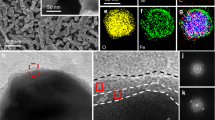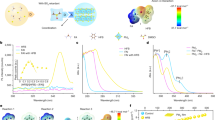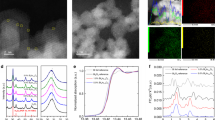Abstract
The ability to engineer a photoelectrode surface is pivotal for optimizing the properties of any photoelectrode used for solar fuel production. Altering crystal facets exposed on the surface of photoelectrodes has been a major strategy to modify their surface structure. However, there exist numerous ways to terminate the surface even for the same facet, which can considerably alter the photoelectrode properties. Here we report tightly integrated experimental and computational investigations of epitaxial BiVO4 photoelectrodes with vanadium- and bismuth-rich (010) facets. Our study demonstrates that even for the same facet the surface Bi:V ratio has a remarkable impact on the interfacial energetics and photoelectrochemical properties. We also elucidate the microscopic origins of how the surface composition can affect the photoelectrochemical properties. This study opens an unexplored path for understanding and engineering surface energetics via tuning the surface termination/composition of multinary oxide photoelectrodes.
This is a preview of subscription content, access via your institution
Access options
Access Nature and 54 other Nature Portfolio journals
Get Nature+, our best-value online-access subscription
$29.99 / 30 days
cancel any time
Subscribe to this journal
Receive 12 digital issues and online access to articles
$119.00 per year
only $9.92 per issue
Buy this article
- Purchase on Springer Link
- Instant access to full article PDF
Prices may be subject to local taxes which are calculated during checkout





Similar content being viewed by others
Data availability
The dataset generated and analysed in the current study are openly available on Qresp44 (Qresp.org) through the University of Chicago node; https://doi.org/10.6084/m9.figshare.13496997.
References
Nozik, A. J. Photoelectrochemistry: applications to solar energy conversion. Ann. Rev. Phys. Chem. 29, 189–222 (1978).
Walter, M. G. et al. Solar water splitting cells. Chem. Rev. 110, 6446–6473 (2010).
Grätzel, M. Photoelectrochemical cells. Nature 414, 338–344 (2001).
Sivula, K. & Van De Krol, R. Semiconducting materials for photoelectrochemical energy conversion. Nat. Rev. Mater. 1, 15010 (2016).
Montoya, J. H. et al. Materials for solar fuels and chemicals. Nat. Mater. 16, 70–81 (2017).
Smith, W. A., Sharp, I. D., Strandwitz, N. C. & Bisquert, J. Interfacial band-edge energetics for solar fuels production. Energy Environ. Sci. 8, 2851–2862 (2015).
Kim, T. W. & Choi, K.-S. Nanoporous BiVO4 photoanodes with dual-layer oxygen evolution catalysts for solar water splitting. Science 343, 990–994 (2014).
Pham, T. A., Ping, Y. & Galli, G. Modelling heterogeneous interfaces for solar water splitting. Nat. Mater. 16, 401–408 (2017).
Nellist, M. R. et al. Potential-sensing electrochemical atomic force microscopy for in operando analysis of water-splitting catalysts and interfaces. Nat. Energy 3, 46–52 (2018).
Li, D. et al. Crystallographic-orientation-dependent charge separation of BiVO4 for solar water oxidation. ACS Energy Lett. 4, 825–831 (2019).
Hu, J., Chen, W., Zhao, X., Su, H. & Chen, Z. Anisotropic electronic characteristics, adsorption, and stability of low-index BiVO4 surfaces for photoelectrochemical applications. ACS Appl. Mater. Interfaces 10, 5475–5484 (2018).
Park, Y., McDonald, K. J. & Choi, K.-S. Progress in bismuth vanadate photoanodes for use in solar water oxidation. Chem. Soc. Rev. 42, 2321–2337 (2013).
Lee, D. K. & Choi, K.-S. Enhancing long-term photostability of BiVO4 photoanodes for solar water splitting by tuning electrolyte composition. Nat. Energy 3, 53–60 (2018).
Kuang, Y. et al. Ultrastable low-bias water splitting photoanodes via photocorrosion inhibition and in situ catalyst regeneration. Nat. Energy 2, 16191 (2017).
Kim, J. H. et al. Hetero-type dual photoanodes for unbiased solar water splitting with extended light harvesting. Nat. Commun. 7, 13380 (2016).
Zhang, W. et al. Anomalous conductivity tailored by domain-boundary transport in crystalline bismuth vanadate photoanodes. Chem. Mater. 30, 1677–1685 (2018).
Brongersma, H. H., Draxler, M., de Ridder, M. & Bauer, P. Surface composition analysis by low-energy ion scattering. Surf. Sci. Rep. 62, 63–109 (2007).
Cushman, C. V. et al. Low energy ion scattering (LEIS). A practical introduction to its theory, instrumentation, and applications. Anal. Methods 8, 3419–3439 (2016).
Purbaix, M. Atlas of Electrochemical Equilibria in Aqueous Solutions (National Association of Corrosion Engineers, 1974).
Wang, W. et al. The role of surface oxygen vacancies in BiVO4. Chem. Mater. 32, 2899–2909 (2020).
Favaro, M. et al. Chemical, structural, and electronic characterization of the (010) surface of single crystalline bismuth vanadate. J. Phys. Chem. C. 123, 8347–8359 (2019).
Seo, H., Ping, Y. & Galli, G. Role of point defects in enhancing the conductivity of BiVO4. Chem. Mater. 30, 7793–7802 (2018).
Bjaalie, L., Himmetoglu, B., Weston, L., Janotti, A. & Van De Walle, C. G. Oxide interfaces for novel electronic applications. N. J. Phys. 16, 025005 (2014).
Balderschi, A., Baroni, S. & Resta, R. Band offsets in lattice-matched heterojunctions: a model and first-principles calculations for GaAs/AlAs. Phys. Rev. Lett. 61, 734–737 (1988).
Kweon, K. E., Hwang, G. S., Kim, J., Kim, S. & Kim, S. Electron small polarons and their transport in bismuth vanadate: a first principles study. Phys. Chem. Chem. Phys. 17, 256–260 (2015).
Wiktor, J., Ambrosio, F. & Pasquarello, A. Role of polarons in water splitting: the case of BiVO4. ACS Energy Lett. 3, 1693–1697 (2018).
Wiktor, J. & Pasquarello, A. Electron and Hole Polarons at the BiVO4–water interface. ACS Appl. Mater. Interfaces 11, 18423–18426 (2019).
Reber, J. F. & Meier, K. Photochemical production of hydrogen with zinc sulfide suspensions. J. Phys. Chem. 88, 5903–5913 (1984).
Govindaraju, G. V., Wheeler, G. P., Lee, D. & Choi, K.-S. Methods for electrochemical synthesis and photoelectrochemical characterization for photoelectrodes. Chem. Mater. 29, 355–370 (2017).
Nečas, D. & Klapetek, P. Gwyddion: an open-source software for SPM data analysis. Cent. Eur. J. Phys. 10, 181–188 (2012).
Swartzfager, D. G. Sensitivity factors for surface analysis by ion scattering spectroscopy. Anal. Chem. 56, 55–58 (1984).
Smith, D. P. Scattering of low-energy noble gas ions from metal surfaces. J. Appl. Phys. 38, 340–347 (1967).
Perdew, J. P., Burke, K. & Ernzerhof, M. Generalized gradient approximation made simple. Phys. Rev. Lett. 77, 3865–3868 (1996).
Giannozzi, P. et al. Advanced capabilities for materials modelling with QUANTUM ESPRESSO. J. Phys. Condens. Matter 29, 465901 (2017).
Giannozzi, P. et al. QUANTUM ESPRESSO: a modular and open-source software project for quantum simulations of materials. J. Phys. Condens. Matter 21, 395502 (2009).
Hamann, D. R. Optimized norm-conserving Vanderbilt pseudopotentials. Phys. Rev. B 88, 085117 (2013).
Schlipf, M. & Gygi, F. Optimization algorithm for the generation of ONCV pseudopotentials. Comput. Phys. Commun. 196, 36–44 (2015).
Cococcioni, M. & De Gironcoli, S. Linear response approach to the calculation of the effective interaction parameters in the LDA+U method. Phys. Rev. B 71, 035105 (2005).
Sun, W. & Ceder, G. Efficient creation and convergence of surface slabs. Surf. Sci. 617, 53–59 (2013).
Ong, S. P. et al. Python materials genomics (pymatgen): a robust, open-source python library for materials analysis. Comput. Mater. Sci. 68, 314–319 (2013).
Hjorth Larsen, A. et al. The atomic simulation environment—a Python library for working with atoms. J. Phys. Condens. Matter 29, 273002 (2017).
Tersoff, J. & Hamann, D. R. Theory of the scanning tunneling microscope. Phys. Rev. B 31, 805–813 (1985).
Zhao, Z., Li, Z. & Zou, Z. Structure and energetics of low-index stoichiometric monoclinic clinobisvanite BiVO4 surfaces. RSC Adv. 1, 874–883 (2011).
Govoni, M. et al. Qresp, a tool for curating, discovering, and exploring reproducible scientific papers. Sci. Data 6, 190002 (2019).
Acknowledgements
This work was supported by the National Science Foundation (NSF) under grant no. CHE-1764399. This research used resources of the Center for Functional Nanomaterials, which is a US DOE Office of Science Facility, at Brookhaven National Laboratory under contract no. DE-SC0012704. This research also used computational resources of the University of Chicago’s Research Computing Center. This research additionally used resources of the National Energy Research Scientific Computing Center (NERSC), a US Department of Energy Office of Science User Facility located at Lawrence Berkeley National Laboratory, operated under Contract no. DE-AC02-05CH11231. The authors would like to thank R. Farber for helpful discussions in processing STM images.
Author information
Authors and Affiliations
Contributions
K.-S.C., G.G. and M.L. supervised the combined experimental and computational investigations. C.Z. prepared epitaxial BiVO4 and performed STM imaging and LEIS analysis of BiVO4 together with X.T. under the supervision of M.L. D.L. performed all other experimental studies of BiVO4 under the supervision of K.-S.C. W.W. performed all computational calculations under the supervision of G.G. All authors discussed the results and contributed to writing the manuscript.
Corresponding authors
Ethics declarations
Competing interests
The authors declare no competing interests.
Additional information
Peer review information Nature Energy thanks Fatwa Abdi, Ian Sharp and the other, anonymous, reviewer(s) for their contribution to the peer review of this work.
Publisher’s note Springer Nature remains neutral with regard to jurisdictional claims in published maps and institutional affiliations.
Supplementary information
Supplementary Information
Supplementary Figs. 1–13, Table 1 and references.
Rights and permissions
About this article
Cite this article
Lee, D., Wang, W., Zhou, C. et al. The impact of surface composition on the interfacial energetics and photoelectrochemical properties of BiVO4. Nat Energy 6, 287–294 (2021). https://doi.org/10.1038/s41560-021-00777-x
Received:
Accepted:
Published:
Issue Date:
DOI: https://doi.org/10.1038/s41560-021-00777-x
This article is cited by
-
Accelerating Oxygen Electrocatalysis Kinetics on Metal–Organic Frameworks via Bond Length Optimization
Nano-Micro Letters (2024)
-
Metal-free photoanodes for C–H functionalization
Nature Communications (2023)
-
Kinetics-induced orientational morphological evolution of Pd-Sb rhombohedra from regular nanocrystals to distorted ones
Science China Materials (2023)
-
Tuning Aerosol Deposition of BiVO4 Films for Effective Sunlight Harvesting
Journal of Thermal Spray Technology (2023)
-
Near-maximum microwave absorption in a thin metal film at the pseudo-free-standing limit
Scientific Reports (2022)



